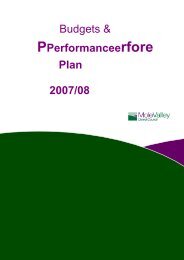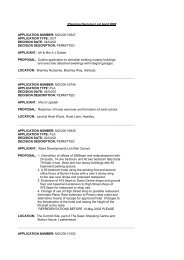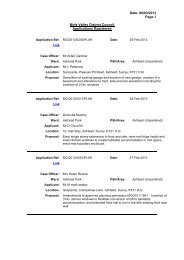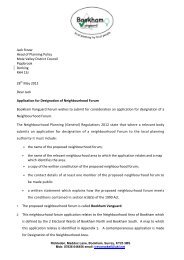MOLE VALLEY NATURAL HISTORY AUDIT BUTTERFLIES
MOLE VALLEY NATURAL HISTORY AUDIT BUTTERFLIES
MOLE VALLEY NATURAL HISTORY AUDIT BUTTERFLIES
You also want an ePaper? Increase the reach of your titles
YUMPU automatically turns print PDFs into web optimized ePapers that Google loves.
Butterfly Indicator Species for Mole Valley<br />
Three butterfly species have been chosen as indicator species for Mole Valley. They are:<br />
Silver-spotted Skipper (Hesperia comma). This is a species of both local and national importance (It<br />
is a Red Data Book Species). One of the largest metapopulations in Britain exists along the North<br />
Downs between Gomshall in the west and Reigate in the east and most of the habitat patches within this<br />
population are in the Mole Valley area. The Silver-spotted Skipper is on the northern edge of its range<br />
in southern Britain and has a very limited distribution, with colonies in the Chilterns, South Downs,<br />
Wiltshire and Dorset in addition to the Surrey population. It needs higher temperatures in which to<br />
breed than any other British butterfly and can only survive on a short sparse sward on south facing<br />
slopes of chalk grassland. Adults are relatively mobile (up to about 5km) and have a high dispersal rate.<br />
As most suitable habitat patches in the area are less than 0.5 hectares in size this means that a number of<br />
such patches must remain in existence for the insect to survive. Loss or degeneration of habitat patches<br />
below a critical level would result in the loss of the entire Surrey population. NB rabbit populations are<br />
in some cases beneficial to the species as rabbit grazing keeps the sward in the right condition but<br />
current very high rabbit populations are in some places damaging the habitat by overgrazing. If<br />
significant changes in rabbit populations occur, monitoring of the effect on Silver-spotted Skipper<br />
colonies will be needed.<br />
Marbled White (Melanargia galathea). This is a grassland species requiring longer sward than the<br />
Silver-spotted Skipper. It has spread slowly along the downs and is now much more widespread than it<br />
was 50 years ago. In Surrey it occured only on chalk grassland up to 1995 but it now appears to be<br />
spreading to other types of grassland and in 1996 has been seen in the Holmwood - Newdigate area.<br />
Monitoring of any further spread will be of great interest.<br />
White Admiral (Ladoga camilla). A woodland species more tolerant of shady conditions than most<br />
butterfly species the White Admiral has spread through Surrey woods in the 20th Century. It will be a<br />
good candidate for monitoring in the 21st Century as populations may change in response to different<br />
methods of woodland management and/or to climatic changes.<br />
For each of these species a 1995 county distribution map is available on a 1km scale. A list of sites in<br />
Mole Valley has been drawn up for each. All three are easily identified in the field. Other local species<br />
which should be monitored in future are: Dingy Skipper, Grizzled Skipper, Green Hairstreak, Brown<br />
Hairstreak, Small Blue, Adonis Blue, Brown Argus, Chalkhill Blue, Purple Emperor, Dark Green<br />
Fritillary, Silver-washed Fritillary and Wall Brown. Current records are held by Gail Jeffcoate and<br />
Surrey Wildlife Trust.
















